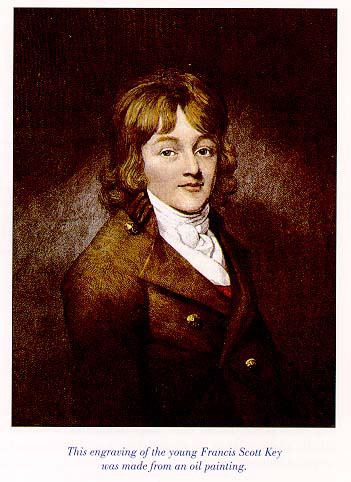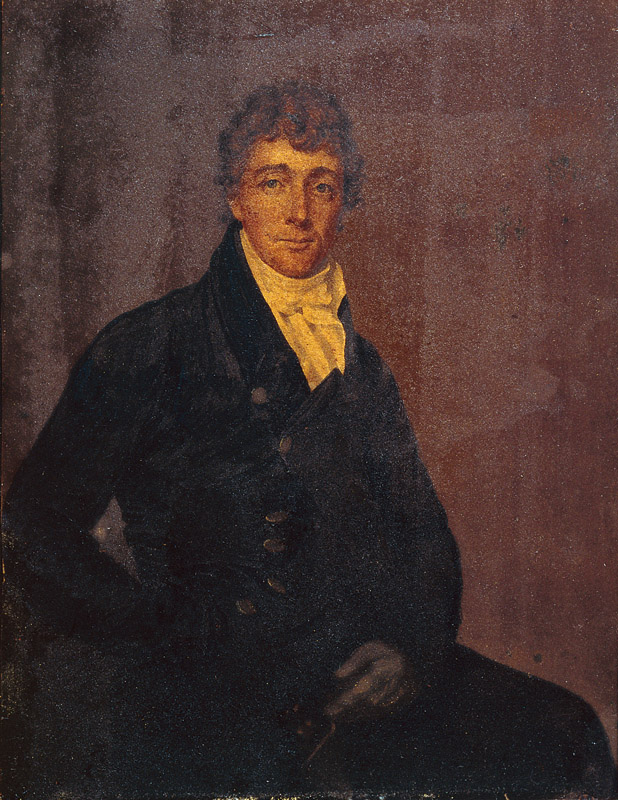
Francis Scot...

Bio-Key,Fran...

Key, Francis...

Francis was born on 10 AUG 1779 in Pipe Creek, Carroll County, Md, the son of John Ross Key and Phoebe Ann Dagworthy Penn Charlton.[Note 3]
He died on 11 JAN 1843 in Baltimore, Maryland.
His wife was Mary Tayloe Lloyd, who he married on 19 JAN 1802 in father's home, Chase House, Annapolis, Maryland. Their eleven known children were Elizabeth Phoebe (1803-1897), Maria Lloyd (1805-1897), Francis Scott (1806-1866), John Ross (1809-1837), Anna Arnold (1811-1884), Edward Lloyd (1813-1822), Daniel Murray (1816-1836), Philip Barton (1818-1859), Ellen Lloyd (1821-1886), Maria Alicia Lloyd Nevins (1823-1886) and Charles Henry (1827-1869).
| | | |||||||
| | ||||||||
| | | |||||||
| |
| Event | Date | Details | Source | Multimedia | Notes | ||||||
|---|---|---|---|---|---|---|---|---|---|---|---|
| Birth | 10 AUG 1779 |
|
See Note 3 | ||||||||
| Death | 11 JAN 1843 |
|
|||||||||
| Burial | 1843 |
|
See Note 4 | ||||||||
| Other Event | 14 SEP 1814 |
|
 Francis Scot... |
 Bio-Key,Fran... |
 Key, Francis... |
Note 1
Francis Scott Key 1779 - 1843 Daily News-Record
Newspaper Location: Harrisonburg, VA, Us
Obituary Publication Date: 14 Jan 2006
Locations Mentioned in Obituary: Annapolis; Congress; Baltimore; MD
Other Persons Mentioned in Obituary: Mary; Fort McHenry Commander
Francis Scott Key, author of the Star Spangled Banner, died January 11, 1843. He was 63.
Key was born in Pipe Creek, Maryland on August 9, 1779. He was a 1796 graduate of St. John?s College in Annapolis. He became a lawyer.
He and his wife Mary had 11 children, six sons and five daughters. They lived in Georgetown where Key had his law practice.
During the War of 1812, the British were bombarding Fort McHenry near Baltimore. The bombardment began on September 13, 1814.
Fort McHenry Commander, General George Armistead, had commissioned a huge flag measuring 30 by 42 feet to fly over the fort.
Key, along with other residents, watched the bombardment, hoping that the Americans could hold out. During the night, the shelling stopped. The British had retreated, and the flag, although tattered by the shelling, was still flying over the fort.
When Key saw the flag, it inspired him to write a song he called the Star Spangled Banner. The lyrics were put to song, and it soon became our national anthem.
Copies of the Star Spangled Banner in Key?s hand are stored at the Maryland Historical Society and the Library of Congress.
Key died January 11, 1843.
Note 2
Francis Scott Key
1780-1843
------------------------------------------------------------------------
Francis Scott Key was a respected young lawyer living in Georgetown just west of where the modern day Key Bridge crosses the Potomac River (the house was torn down after years of neglect in 1947). He made his home there from 1804 to around 1833 with his wife Mary and their six sons and five daughters. At the time, Georgetown was a thriving town of 5,000 people just a few miles from the Capitol, the White House, and the Federal buildings of Washington.
But, after war broke out in 1812 over Britian's attempts to regulate American shipping and other activities while Britain was at war with France, all was not tranquil in Georgetown. The British had entered Chesapeake Bay on August 19th, 1814, and by the evening of the 24th of August, the British had invaded and captured Washington. They set fire to the Capitol and the White House, the flames visible 40 miles away in Baltimore.
President James Madison,his wife Dolley, and his Cabinet had already fled to a safer location. Such was their haste to leave that they had had to rip the Stuart portrait of George Washington from the walls without its frame!
A thunderstorm at dawn kept the fires from spreading. The next day more buildings were burned and again a thunderstorm dampened the fires. Having done their work the British troops returned to their ships in and around the Chesapeake Bay.
In the days following the attack on Washington, the American forces prepared for the assault on Baltimore (population 40,000) that they knew would come by both land and sea. Word soon reached Francis Scott Key that the British had carried off an elderly and much loved town physician of Upper Marlboro, Dr. William Beanes, and was being held on the British flagship TONNANT. The townsfolk feared that Dr. Beanes would be hanged. They asked Francis Scott Key for his help, and he agreed, and arranged to have Col. John Skinner, an American agent for prisoner exchange to accompany him.
On the morning of September 3rd, he and Col. Skinner set sail from Baltimore aboard a sloop flying a flag of truce approved by President Madison. On the 7th they found and boarded the TONNANT to confer with Gen. Ross and Adm. Alexander Cochrane. At first they refused to release Dr. Beanes. But Key and Skinner produced a pouch of letters written by wounded British prisoners praising the care they were receiving from the Americans, among them Dr. Beanes. The British officers relented but would not release the three Americans immediately because they had seen and heard too much of the preparations for the attack on Baltimore. They were placed under guard, first aboard the H.M.S. Surprise, then onto the sloop and forced to wait out the battle behind the British fleet.
Now let's go back to the summer of 1813 for a moment. At the star-shaped Fort McHenry, the commander, Maj. George Armistead, asked for a flag so big that "the British would have no trouble seeing it from a distance". Two officers, a Commodore and a General, were sent to the Baltimore home of Mary Young Pickersgill, a "maker of colours," and commisioned the flag. Mary and her thirteen year old daughter Caroline, working in an upstairs front bedroom, used 400 yards of best quality wool bunting. They cut 15 stars that measured two feet from point to point. Eight red and seven white stripes, each two feet wide, were cut. Laying out the material on the malthouse floor of Claggett's Brewery, a neighborhood establishment, the flag was sewn together. By August it was finished. It measured 30 by 42 feet and cost $405.90. The Baltimore Flag House, a museum, now occupies her premises, which were restored in 1953.
At 7 a.m. on the morning of September 13, 1814, the British bombardment began, and the flag was ready to meet the enemy. The bombardment continued for 25 hours,the British firing 1,500 bombshells that weighed as much as 220 pounds and carried lighted fuses that would supposedly cause it to explode when it reached its target. But they weren't very dependable and often blew up in mid air. From special small boats the British fired the new Congreve rockets that traced wobbly arcs of red flame across the sky. The Americans had sunk 22 vessels so a close approach by the British was not possible. That evening the connonading stopped, but at about 1 a.m. on the 14th, the British fleet roared to life, lighting the rainy night sky with grotesque fireworks.
Key, Col. Skinner, and Dr. Beanes watched the battle with apprehension. They knew that as long as the shelling continued, Fort McHenry had not surrendered. But, long before daylight there came a sudden and mysterious silence. What the three Americans did not know was that the British land assault on Baltimore as well as the naval attack, had been abandoned. Judging Baltimore as being too costly a prize, the British officers ordered a retreat.
Waiting in the predawn darkness, Key waited for the sight that would end his anxiety; the joyous sight of Gen. Armisteads great flag blowing in the breeze. When at last daylight came, the flag was still there!
Being an amatuer poet and having been so uniquely inspired, Key began to write on the back of a letter he had in his pocket. Sailing back to Baltimore he composed more lines and in his lodgings at the Indian Queen Hotel he finished the poem. Judge J. H. Nicholson, his brother-in-law, took it to a printer and copies were circulated around Baltimore under the title "Defence of Fort M'Henry". Two of these copies survive. It was printed in a newspaper for the first time in the Baltimore Patriot on September 20th,1814, then in papers as far away as Georgia and New Hampshire. To the verses was added a note "Tune: Anacreon in Heaven." In October a Baltimore actor sang Key's new song in a public performance and called it "The Star-Spangled Banner".
Immediately popular, it remained just one of several patriotic airs until it was finally adopted as our national anthem on March 3, 1931. But the actual words were not included in the legal documents. Key himself had written several versions with slight variations so discrepancies in the exact wording still occur.
The flag, our beloved Star-Spangled Banner, went on view ,for the first time after flying over Fort McHenry, on January 1st,1876 at the Old State House in Philadelphia for the nations' Centennial celebration. It now resides in the Smithsonian Institution's Museum of American History. An opaque curtain shields the now fragile flag from light and dust. The flag is exposed for viewing for a few moments once every hour during museum hours.
Francis Scott Key was a witness to the last enemy fire to fall on Fort McHenry. The Fort was designed by a Frenchman named Jean Foncin and was named for then Secretary of war James McHenry. Fort McHenry holds the unique designation of national monument and historic shrine.
Since May 30th, 1949 the flag has flown continuously, by a Joint Resolution of Congress, over the monument marking the site of Francis Scott Key's birthplace, Terra Rubra Farm, Carroll County, Keymar, Maryland.
The copy that Key wrote in his hotel September 14,1814, remained in the Nicholson family for 93 years. In 1907 it was sold to Henry Walters of Baltimore. In 1934 it was bought at auction in New York from the Walters estate by the Walters Art Gallery, Baltimore for $26,400. The Walters Gallery in 1953 sold the manuscript to the Maryland Historical Society for the same price. Another copy that Key made is in the Library of Congress.
------------------------------------------------------------------------
http://www.usflag.org/francis.scott.key.html August 2, 2003
Note 3
Name: Francis Scott Key
Spouse: Mary Tayloe Lloyd
Parents: John Ross Key, Ann Phoebe Penn Dagworth Charlton
Birth Place: Carroll CO, Pipe Creek, MD
Birth Date: 10 Aug 1779
Marriage Place: Pipe Creek, Carol CO, MD
Marriage Date: 19 Jan 1802
Death Place: Baltimore, MD
Death Date: 11 Jan 1843
Source Citation: Birth year: 1779; Birth city: Pipe Creek; Birth state: MD.
Source Information:
Edmund West, comp.. Family Data Collection - Individual Records [database on-line]. Provo, UT, USA: The Generations Network, Inc., 2000.
Description:
The Family Data Collection - Individual Records database was created while gathering genealogical data for use in the study of human genetics and disease.
Note 4
from brochure of Mount Olivet Cemetery:
Grave of Francis Scott Key.....Over his grave and monument..the Stars and Stripes is never lowered.
....
....
Near the entrance of this beautiful cemetery stands this fitting monument. Designed by Alexander Doyle of New Yourk City, it was dedicated with appropirate ceremonies on August 9, 1898. It was paid for by dollars and dimes contribted by individuals from all over the country, supplemented by an appropriation of $5,000 from the State of Maryland in 1897. Its total cost was in excess of $25,000/ the figure of Key is 9'5" in heights, the monument itself is 16' and the circumference is 45'.
..Redidication ceremonies weere held at Mt. Oliver Cemetery on June 7, 1987..